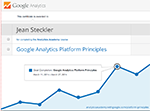Business decisions need more information than the number of visits per month and the number of referrals generated is a small tip of the data iceberg. Through sophisticated analytical tools which can attribute credit to the events that lead up to a sale, we can understand — and improve — the path that drives customers to us. Once we have a good understanding of the pain points of existing customers and how they find us, we can improve our marketing to find more customers just like them.
Web Site Key Performance Indicators (KPIs)
Once built, the marketing team continuously monitors the site’s key performance indicators, which may include:
- Online Sales (eCommerce sites)
- Visitors
- Conversions
- Leads
- Qualified Leads
- Domain Authority
- Page Ranks
- Page Authority
- Page Views
- Bounce Rates
- Errors (e.g. Pages not found, Server errors)
Attribution
The better insights a company has into the needs of their customers, the better they can align their products to meet those needs. The old adage of “looking outside the factory door” now also involves monitoring prospects’ and customers’ online behaviors.
Tools such as Google Analytics’ Multi-Channel Funnel help us understand the digital channels that drive sales. Google’s attribution modeling is one of the tools we use to infer customer needs from the referring sites, the search terms, social, email, the industries, and geographies. These insights help us in messaging, building personalized landing pages, and offers.
Certifications
- Google Analytics Platform Principles Certificate
- Google Ecommerce Analytics: From-Data to Decisions
- Google Tag Manager Certificate












Recent Comments